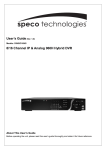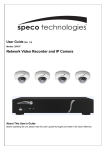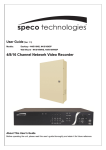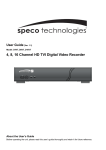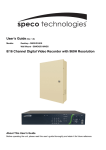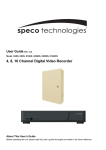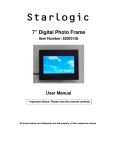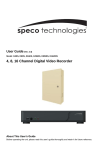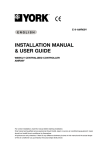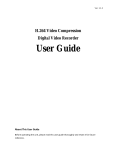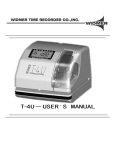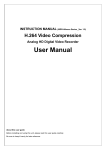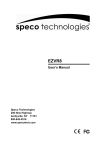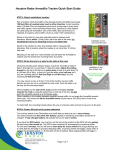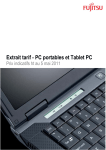Download NS USER GUIDE - Surveillance
Transcript
User Guide (Ver. 1.3) Models: N4/8NSL 4/8 Channel Network Video Recorder About This User’s Guide Before operating the unit, please read this user’s guide thoroughly and retain it for future reference. Cautions Explanation of Graphical Symbols This symbol indicates the presence of important operating and maintenance (servicing) instructions in the literature accompanying the product. This symbol indicates the presence of “dangerous voltage” within the product’s enclosure that may be of sufficient magnitude to constitute a risk of electric shock, property damage, personal injury, or death. WARNING To reduce a risk of fire or electric shock, do not expose this product to rain or moisture. CAUTION Changes or modifications not approved by the manufacture will void the warranty of the product. Using an incompatible battery may increase the risk of fire or explosion. Replace only with the same or equivalent type battery recommended by the manufacture. Discard used batteries according to manufacturer’s instructions. 2 These precautions must be followed for safety reasons Warning Do not use if the unit emits smoke. Do not disassemble the unit. Do not place any heavy or sharp objects on the unit. Do not place on uneven surface. Do not expose to shock or vibration. Do not move the unit when the unit is powered on. Do not block, and allow dust to accumulate in the air vents. Do not restrict airflow of the unit; doing so can damage the unit. Only qualified and experienced personnel should perform installation and servicing. Turn off the power of the NSL when connecting Cameras, Audio Cables. The manufacturer is not responsible for any damage caused by improper use of the product or failure to follow instructions for the product. The manufacturer is not responsible for any problems caused by or resulting from the user physically opening the NSL for examination or attempting to repair the unit. For NSL models with the PoE Switch, it is strongly recommended that the 48V connector is inserted to the PoE Switch before the AC cable is attached to the adaptor. 3 Product Components Please make sure the following components are included as specified below. Desktop: N4NSL / N8NSL Remote Control Battery 1.5V (AAA x 2 EA) Quick Setup Guide & User Guide Mouse for NSL Software & Manual CD Power Adaptor (DC48V for POE) N4NSL : 1.2A, N8NSL : 2A & Power cable (110V or 220V) 4 Specifications for NSL MODEL NAME N4NSL N8NSL Description 4ch NVR with 4-PoE 8ch NVR with 8-PoE 4 8 IP Camera (Throughput) Input Video Normal Resolution Max. 1920x1080 Highest Resolution Not Support Main Monitor VGA and HDMI (Max. 1920x1080) Sub Monitor None Output IP Camera (Network) 4 8 Local Input (RCA) None None Local Output (RCA) 1 1 Input Audio Output Audio Codec G.711 Sensor IP Camera (Network) 4 8 In Local Input (Terminal Block) None None Local Alarm Output (Terminal Block) None None Event Motion Detection (from IP Camera) Yes RS-232C None None RS-485 None None Private (IP Camera, Auto Connection) 802.3af x 4 802.3af x 8 LAN (IP Camera, Remote Access) 10/100 Base-TX 10/100/1000 Base-TX Serial Network TCP/IP, UDP, DHCP, HTTP, NTP, SMTP, RTP, RTSP, Protocols ONVIF Streaming Live Relay of the IP Camera's Sub-stream Frame Rate 120fps 240fps Frame Rate 120fps 240fps Recording Mode Smart / Continuous / Motion / Sensor / Schedule / Manual Pre Recording Max. 20 Minutes Post Recording Max. 60 Seconds Search Smart Search, EZ Search, Date/Time, Event, Archive, Log Recording Playback Multi-Decoding Backup Storage HDD 1, 4 1, 4, 8 Playback Speed x0.25, x0.5, x2, x4, x8, x16, x32, x64 Media USB drive, External HDD, Network File Format BMP, AVI, Proprietary Format Huge Backup BMP, AVI, Proprietary Format Capacity of 1 HDD 3TB 3TB Internal HDDs 1 1 e-SATA None None 5 Front 1 1 Rear 1 1 USB User I/F Input Method IR, Mouse Dynamic DNS Yes (Free DDNS) Digital Zoom Yes DLS (Day Light Saving) Yes NTP (Network Time Protocol) Yes S.M.A.R.T Yes Internal Beep Yes Multi-Language Yes e-mail Notification Yes 3G Mobile iPad / iPhone / Android Network Web Viewer Windows (IE, Chrome, Firefox, Safari) Access PC Client Single / Multi Client and CMS (64 channels) Remote Setup and Upgrade Yes Features Power Power Supply Voltage DC 48V 1.2A (57.6Watt) Operation DC 48V 2.0A(96Watt) 41° F ~ 104° F (5°C ~ 40°C) Temperature Storage 14° F ~ 122° F (-10°C ~ 50°C) Humidity Operation 20% ~ 80% (Non-condensing) Dimension Unit Dimension (W x H x D) 11.8' x 8.9' x 2.0' (300mm x 227mm x 53mm) Please note that specifications and unit exterior design are subject to change without notification. 6 Table of Contents 1. Main Features ............................................................................................................................. 10 2. Initial Boot-up Process.................................................................................................................. 11 2-1. Initial Boot up and Basic Time Setup ..................................................................................... 11 2-2. Setting up Daylight Savings Time .......................................................................................... 12 2-3. Setting NTP (Network Time Protocol) .................................................................................... 12 2-4. EZ SETUP ............................................................................................................................ 15 2-5. PoE Port SETUP ................................................................................................................... 16 2-6 . IP Camera SETUP (through Web Viewer page) ................................................................... 19 2-7 . Dual Streaming ..................................................................................................................... 19 3. Front and Rear Panels ................................................................................................................ 20 3-1. Desktop Front Panel ............................................................................................................. 20 3-2. Connectors ........................................................................................................................... 20 3-3. Remote Control ..................................................................................................................... 21 4. Setting up the NSL ...................................................................................................................... 22 4-0. Setup – Main Live Screen ..................................................................................................... 22 4-1. Setup – IP CAMERA ............................................................................................................. 23 4-1-1. SCAN Menu ....................................................................................................................... 25 4-1-2. ONVIF SETUP Menu ......................................................................................................... 26 4-2. Setup – SYSTEM .................................................................................................................. 28 4-3. Setup – RECORD Mode ....................................................................................................... 31 4-3-1. Recording Schedules ......................................................................................................... 33 4-4. Setup – DEVICE Mode ......................................................................................................... 34 4-4-1. Digital Deterrent ................................................................................................................. 35 4-4-2. Motion Zone Setup............................................................................................................. 36 4-5. Setup – DISPLAY Mode ........................................................................................................ 37 4-6. Setup – NETWORK Mode..................................................................................................... 38 4-6-1. Network Types ................................................................................................................... 39 4-6-2. DDNS ................................................................................................................................ 39 4-6-3. Network Port and Web Port................................................................................................ 40 4-7. Setup – USER MANAGEMENT Mode ................................................................................... 40 4-8. Setup – STORAGE Mode ..................................................................................................... 42 4-9. Setup - CONFIG Mode .......................................................................................................... 43 4-9-1. Firmware Upgrade ............................................................................................................. 44 5. Live, Search and Playback .......................................................................................................... 45 5-1. Live View .............................................................................................................................. 45 5-2. Digital Zoom in Live and Playback Screen ............................................................................ 49 5-3. SEARCH Screen ................................................................................................................... 49 5-3-1. EZSearch ........................................................................................................................... 50 5-3-2. Time Line Search ............................................................................................................... 51 7 5-3-3. Event Search ..................................................................................................................... 51 5-3-4. Go To First Time................................................................................................................. 52 5-3-5. Go To Last Time ................................................................................................................. 52 5-3-6. Go To Specific Time ........................................................................................................... 52 5-3-7. Archive List ........................................................................................................................ 52 5-3-8. Log List .............................................................................................................................. 53 5-4. Play Mode ............................................................................................................................. 53 6. Back Up ........................................................................................................................................... 55 6-1. Still Image Backup onto USB Flash Drive.............................................................................. 55 6-2. Video Backup onto USB Flash Drive during playback ........................................................... 55 6-2. EZCopy: Video Backup onto USB Flash Drive during playback............................................. 57 6-3. Transferring Still Images or Video from the ARCHIVE List ..................................................... 58 6-4. Playback of Backup Video ..................................................................................................... 59 6-5-1. AVI Format ......................................................................................................................... 59 6-5-2. NSF Format ....................................................................................................................... 59 7. Network Access Using the Multi-Sites Network Viewer .................................................................... 60 7-1. Overview ............................................................................................................................... 60 7-2. PC Requirements .................................................................................................................. 60 7-3. Installation of the Program .................................................................................................... 61 7-4. Live Window.......................................................................................................................... 62 7-4-1. Main User Interface............................................................................................................ 62 7-4-2. Control Buttons .................................................................................................................. 62 7-5. Search and Playback Window ............................................................................................... 63 7-5-1. Main User Interface............................................................................................................ 63 7-5-2. Main Control Panel ............................................................................................................ 64 7-6. Setup of SpecoTech Multi Client ............................................................................................ 65 7-6-1. General .............................................................................................................................. 65 7-6-2. Event ................................................................................................................................. 66 7-6-3. Record ............................................................................................................................... 67 7-6-4. Display ............................................................................................................................... 68 7-6-5. Language ........................................................................................................................... 69 7-6-6. About ................................................................................................................................. 69 7-7. Remote Setup ....................................................................................................................... 70 7-7-1. IP Camera.......................................................................................................................... 71 7-7-2. System............................................................................................................................... 71 7-7-3. Record ............................................................................................................................... 73 7-7-4. Device................................................................................................................................ 73 7-7-5. Display ............................................................................................................................... 75 7-7-6. Network ............................................................................................................................. 75 7-7-7. User Management ............................................................................................................. 76 7-7-8. Storage .............................................................................................................................. 77 8 7-7-9. Remote Upgrade................................................................................................................ 77 7-7-10. Information ....................................................................................................................... 77 7-8. Operation .............................................................................................................................. 78 7-8-1. Addition, Delete, and Modify of NSL Sites .......................................................................... 78 7-8-2. Connect and Disconnect .................................................................................................... 79 7-8-3. Still-image Capture During Live .......................................................................................... 80 7-8-4. Recording Video on Local PC During Live ......................................................................... 81 7-8-5. Local Playback and Remote Playback ............................................................................... 82 7-8-6. AVI Backup during Playback .............................................................................................. 84 8. Network Access Using the Web-Browser Viewer .............................................................................. 86 9. Network Access Using the Smart Phone Viewer .............................................................................. 88 9-1. App Viewer for iPhone ........................................................................................................... 88 9-1-1. Live .................................................................................................................................... 88 9-1-2.PTZ Control ........................................................................................................................ 90 9-1-3. Playback ............................................................................................................................ 90 9-2. App Viewer for Android Phone............................................................................................... 91 9-2-1. Live .................................................................................................................................... 91 9-2-2. Playback ............................................................................................................................ 92 9-2-3.PTZ Control ........................................................................................................................ 93 APPENDIX: Network Connection - LAN ............................................................................................... 93 APPENDIX: Network Connection – Internet and DDNS ....................................................................... 96 9 1. Main Features Automatic IP Camera Detection and connection (Plug & Play) Easy Record, Copy and Setup Easy Search by Thumbnail Preview Easy Copy Easy Network Easy IP Camera Setup NOTE: Under federal law, The Fourth Amendment to the U.S. Constitution, Title III of the Omnibus Crime Control and Safe Streets Act of 1968, as amended by the Electronic Communications Privacy Act of 1986 (18 Individual Channel Operation U.S.C. § 2510, et seq.), and the Foreign Intelligence Surveillance Act of 1978 (50 U.S.C. 1801, et seq.) permit government agents, acting with the consent of a party to a communication, to engage in warrantless interceptions of telephone communications, as well as oral and electronic communications. Covert camera operation provides enhanced security and administrator control Dynamically programmable recording priority, motion detection, alarms and scheduling Simple and Easy Graphic User Interface Simple Scheduler HDMI Output VGA Output Password to secure installation authorization Network software supports 10/100Mbps USB 2.0 port for video clip exporting and easy firmware upgrade via USB Flash Drive 10 2. Initial Boot-up Process 2-1. Initial Boot up and Basic Time Setup 1. During the first boot up, the following logo will be displayed. 2. After the logo, select the language and set date and time as specified below. 11 2-2. Setting up Daylight Savings Time To enable Daylight Saving feature/NTP synchronization, take the following steps. 1. Enter the SETUP mode. The default Username is “ADMIN” and Password is “1111”. 2. Go to SETUP > SYSTEM > DATE & TIME SETUP 3. Select ON from the DAYLIGHT SAVING dropdown menu. 2-3. Setting NTP (Network Time Protocol) 1. SETUP > SYSTEM > NTP SETUP > ON 12 2. Select the proper TIME ZONE time. Table2.3.1. GMT Time Zone State Standard Time Daylight-Saving Time AL Alabama GMT-6 GMT-5 AK Alaska GMT-9 GMT-8 AK Alaska (Aleutian Islands) GMT-10 NA AZ Arizona GMT-7 NA AZ Arizona (Navajo) GMT-7 GMT-6 AR Arkansas GMT-6 GMT-5 CA California GMT-8 GMT-7 CO Colorado GMT-7 GMT-6 CT Connecticut GMT-5 GMT-4 DC District of Columbia GMT-5 GMT-4 DE Delaware GMT-5 GMT-4 FL Florida GMT-5 GMT-4 FL Florida (W) GMT-6 GMT-5 GA Georgia GMT-5 GMT-4 HI Hawaii GMT-10 NA ID Idaho (N) GMT-8 GMT-7 ID Idaho (S) GMT-7 GMT-6 IL Illinois GMT-6 GMT-5 IN Indiana GMT-5 GMT-4 IN Indiana (SW / NW) GMT-6 GMT-5 IA Iowa GMT-6 GMT-5 KS Kansas GMT-6 GMT-5 KS Kansas (W) GMT-7 GMT-6 KY Kentucky (E) GMT-5 GMT-4 KY Kentucky (W) GMT-6 GMT-5 LA Louisiana GMT-6 GMT-5 ME Maine GMT-5 GMT-4 MD Maryland GMT-5 GMT-4 MA Massachusetts GMT-5 GMT-4 MI Michigan GMT-5 GMT-4 13 MI Michigan (W) GMT-6 GMT-5 MN Minnesota GMT-6 GMT-5 MS Mississippi GMT-6 GMT-5 MO Missouri GMT-6 GMT-5 MT Montana GMT-7 GMT-6 NE Nebraska GMT-6 GMT-5 NE Nebraska (W) GMT-7 GMT-6 NV Nevada GMT-8 GMT-7 NH New Hampshire GMT-5 GMT-4 NJ New Jersey GMT-5 GMT-4 NM New Mexico GMT-7 GMT-6 NY New York GMT-5 GMT-4 NC North Carolina GMT-5 GMT-4 ND North Dakota GMT-6 GMT-5 ND North Dakota (W) GMT-7 GMT-6 OH Ohio GMT-5 GMT-4 OK Oklahoma GMT-6 GMT-5 OR Oregon GMT-8 GMT-7 OR Oregon (E) GMT-7 GMT-6 PA Pennsylvania GMT-5 GMT-4 RI Rhode Island GMT-5 GMT-4 SC South Carolina GMT-5 GMT-4 SD South Dakota (E) GMT-6 GMT-5 SD South Dakota (W) GMT-7 GMT-6 TN Tennessee (E) GMT-5 GMT-4 TN Tennessee (W) GMT-6 GMT-5 TX Texas GMT-6 GMT-5 TX Texas (W) GMT-7 GMT-6 UT Utah GMT-7 GMT-6 VT Vermont GMT-5 GMT-4 VA Virginia GMT-5 GMT-4 WA Washington GMT-8 GMT-7 WV West Virginia GMT-5 GMT-4 WI Wisconsin GMT-6 GMT-5 WY Wyoming GMT-7 GMT-6 NOTE: If you want the unit to automatically synchronize the local time, the Time Zone must be properly set according to your local time zone. 14 2-4. EZ SETUP Quick installation Menu for NSL and IP Camera Easy installation(Right-Click on the Main Screen) Figure 2.4. EZ Setup Screen 2.4.1. Setup DATE & TIME, IP CAMERA configurations. 1 2 3 4 Figure 2.4.1. EZ CAMERA Setup Procedure ① Select EZ Camera for Date/Time and Camera Setup, Click NEXT to proceed. ② Description of EZ Camera Setup is displayed, Click NEXT to proceed. ③ Set up the Date/Time settings and click NEXT to get to the camera setup. ④ Configure individual cameras in the EZ Camera Setup. Select the Channel to configure. Select the Camera Protocol and then click on the scan button; this will scan the networks for any cameras from the particular protocol. Select on the desired Camera from the list, and then check on register. If necessary, click on Preview to Preview the camera, or Setup to change camera settings. 15 2.4.2. EZ NETWORK Figure 2.4.2. EZ NETWORK Setup Procedure ① Select EZ Network for Network Setup. ② It begins to test and detect the network environment automatically. ③ DDNS hostname will be setting up. ④ If needed, edit the hostname ⑤ When you finish EZ network setup and close the window, it displays the result. 2-5. PoE Port SETUP Figure 2.5.1 PoE Port (N4NSL / N8NSL) 16 2.5.1 Connecting the Camera Figure 2.5.1.1 IP Camera Connection Diagram (N4NSL, N8NSL) Clients WAN IP Cameras LAN Switch Hub Internet Router Clients Figure 2.5.1.2 IP Camera Connection Diagram (NSL Series) 17 able 2.5.1. Factory Default of the IP Camera The following IP Camera settings are recommended for optimal connection with the NSL Series Setup Items Default Description Network Type DHCP The IP Camera must act as a DHCP client for the “Plug and Play”. Encoding Type CBR The “CBR” is recommended because of the internal buffer design of the NSL Series Resolution 1280x720 The maximum performance of the N8NSL is 1080p@240fps or 720p@240fps. To get higher frame rates per channel, 1280x720 is the recommended resolution. Frame Rate 25fps The maximum performance of the N8NSL is 720p@240fps. Therefore 30fps per channel is recommended. (30fps x 8 = 240fps) Bit Rate 2Mbps The maximum throughput of the N8NSL is 40Mbps. Therefore 2Mbps per channel is recommended. (4Mbps x 8 = 32Mbps) Sub Stream CIF For “Dual Streaming”, the sub stream should be turned on. 512Kbps And for the proper streaming through the WAN connection, CIF@512Kbps or lower bitrates per channel is recommended. The NSL Series features a "Plug and Play" function with a PoE Switch. The “Plug and Play” functionality requires the IP Camera to be in DHCP mode. The NSL automatically assigns an IP Address to the IP Camera. (10.20.30.11 ~ 10.20.30.254) The NSL models will automatically map the camera on the PoE Port to the corresponding NVR channel number. The NSL PoE Port maximum power consumption - [N4NSL – 57.6Watt, N8NSL-96Watt] Figure 2.5.1.2. Incorrect connection with the PoE Ports With the NSL Models, it is prohibited to connect a router to the POE Ports to connect the IP Camera, the NSL will not be able to find and connect to the camera. connected to a router, but not the PoE Ports. 18 The LAN Port can be 2-6 . IP Camera SETUP (through Web Viewer page) NSL Series allow remote access to the IP Cameras through an "IP Camera Setup" menu. The PC Web Client features the "IP Camera Setup" menu that can be accessed remotely. ① Click the mouse right button ② Select “IP Camera Setup”. ③ Select Channel Number. ④ It launches the camera’s web setup page. In order for the web pages to launch from the “IP Camera Setup” menu when accessed from the WAN, Ports 59011 to 59254 on the router must be port forwarded to the NVR. The local address of the NVR can be found in the system information 2-7 . Dual Streaming High Quality (Main Profile) Video Stream is used for both Recording and Live Display. High Quality (Main Profile) Video Stream can be viewed through the network, when selected. Normal (Secondary) Quality Video Stream is used by default when viewing through the network. Monitoring High/Normal Live Display Selection Network IP Camera Network Clients Recording 19 High Quality Video Stream (Full HD) Normal Quality Video Stream (D1/CIF) HDD 3. Front and Rear Panels 3-1. Desktop Front Panel Figure 3.1.1. Desktop NSL Front panel Table 3.1.1. Front LED and Port of NSL Name Description LED light is on when power is applied to the system. POWER LED light is on when the system is recording video data. HDD This USB port for archiving footage into a USB device. (USB 2.0) USB Port 3-2. Connectors Do not power this system on before all the connections are completed. Make sure all the connections are properly secured. Faulty connection may result in the system being damaged. 1 3 4 5 7 8 2 6 [N4NSL] 1 4 5 3 8 7 6 2 [N8NSL] Figure 3.2.1. Connectors for NSL ① Power Switch: Use for power on/off. ② POWER: DC48V input. ③ PoE PORT: N4NSL (4 Port PoE-57.6Watt), N8NSL(8 Port PoE-96Watt) ④ WAN PORT: Network Port for Internet ⑤ AUDIO OUTPUT: 1 Connector for Audio Output ⑥ USB PORT: Connector for USB Mouse or USB flash memory. 20 ⑦ HDMI OUT: HDMI output port, Connector to the HDMI Monitor, (1280x720, and 1920x1080). ⑧ VGA OUT: Connector for VGA Monitor, Main Video Output. 3-3. Remote Control Figure 2.3.1. Remote Controller Button ① ID: To set the remote control ID. ② REC: To start and stop manual recording ③ SEARCH: To go to SEARCH menu. ④ F/ADV: During playback – To move the playback position 60 seconds forward . During Pause – To move the playback position moves 1 frame forward ⑤ F/REW: During playback – To move the playback position 60 seconds back. During Pause – To move the playback postion 1 frame back. ⑥ FF: To fast forward the recording. ⑦ PLAY/PAUSE: To play or to pause the recording in playback mode ⑧ REW: To rewind the recording. ⑨ ESC: During setup – To retun to the preivous menu screen. During Playback – To exit playback mode System lock – To lock a system when pressing ESC button for 5 seconds. System unlock – To unlock a system when pressing ESC button for 5 seconds. ⑩ SETUP: To open the SETUP menu. ⑪ Direction buttons: To move menu items or select a channel. ⑫ SEQ: To start auto sequencing the screen in full screen mode. (Toggle) ⑬ BACKUP: To start a backup operations in live or playback mode ⑭ 0~9: To select channel (1,2,3,..) or to enter a DVR ID number or use as number key. 21 4. Setting up the NSL The following sections detail the initial setup of the NSL. Menu screen will close if user input is not received within 5 minutes. 4-0. Setup – Main Live Screen To enter the setup menu, right click on the mouse and select setup from the submenu or press the setup button on the remote control. Table 4.0.1. Live Screen and Quick Operation Window When the NS prompts the LOG-IN window, enter the PASSWORD using the virtual keyboard, or the front panel, or the remote control. For ADMIN, the factory default password is 1111. It is highly recommended to assign a new password to protect the system. User can assign a new password in SECURITY setup menu. 22 4-1. Setup – IP CAMERA Press the SETUP button and enter the password. The IP Camera setup menu is displayed below. Figure 4.1.1. IP Camera mode setup screen Table 4.1.1. Menu items in IP CAMERA mode setup Item Description CHANNEL To manually connect each camera, click on the to get this window: Under the column labeled Type, Select IP Camera Manufacturer. Double Click to Scan SCAN: Double click the empty box to search IP camera on the local network. 23 IP: Enter the address of IP camera to connect, or select from scanned list. PORT: Enter the port number of IP camera to connect WEB PORT: Enter the web port number of IP camera to connect OTHERS: Change the IP camera setting. Double click the empty box and then Log-In box will be pop-up. (Enter ID and PASSWORD of IP Camera) PROTOCOL Select the protocol for the IP Camera. SCAN Automatic IP Camera search on the local network. IP Set up IP camera address. PORT Set up the RTSP port of the IP Camera (default: 554) WEB PORT Set up the web port of IP Camera (default: 80) ID Enter ID of IP CAM PASSWORD Enter the PASSWORD of IP CAM 24 4-1-1. SCAN Menu Scan for IP Cameras on network using ONVIF/SPECO protocols.protocols . Figure 4.1.2 IP CAMERA Setup Screen Figure 4.1.3 Left Image using ONVIF Protocol SCAN, Right Image using SPECO Protocol SCAN \ Figure 4.1.4 ONVIF Protocol Profile SCAN Image ① Select the protocol used by the IP Camera and then click the scan button. ② Select the IP Camera from the list and then click the register button. ③ After registering, the basic information is displayed. ④ IP cameras using ONVIF protocol require ID, Password and Profile to be correctly entered for proper operation. ⑤ SPECO protocols only require ID and Password to be correctly entered for proper operation. IP cameras using ONVIF protocol can have their Video, Network and System settings accessed and updated using the ONVIF setup menu. (ONVIF Setup Menu may not be accessible depending on the ONVIF version used by the IP camera.) 25 4-1-2. ONVIF SETUP Menu Figure 4.1.2 IP CAMERA Setup Screen (ONVIF) The NSL Series can search for IP Cameras that are conformant to ONVIF (Open Network Video Interface Forum). In order to search for ONVIF Cameras, the field associated with VENDOR has to be set to ONVIF. Click on the Box associated with SCAN to scan the networks for ONVIF Conformance cameras. Figure 4.1.4 ONVIF Camera Scan Window Figure 4.1.5 ONVIF Profile Scan Window ① Select ONVIF for Vendor and click the SCAN button. ② Select the camera on the list and then click the register button. ③ Then, PROFILE and ONVIF setting button will be displayed on the menu. Click PROFILE button and then the detail information of ONVIF will be searched and listed. (If the camera is not on the list, then the ONVIF protocol of the IP CAM is not compatible with the NVR and there not supported. ) 26 ④ Double click the listed profile to apply. ⑤ Enter ID and PASSWORD of IP CAM. Registration is .completed. Figure 4.1.6 ONVIF Setup Window Under ONVIF Setup, the following can be viewed and changed: VIDEO, NETWORK, SYSTEM settings. Menu Item Description VIDEO Video, Encoder to view and change to audio settings. NETWORK View and change Network settings. SYSTEM System information and change your password, factory reset and the camera is rebooting. 27 4-2. Setup – SYSTEM In the SETUP menu, select the SYSTEM tab. Then, the SYSTEM menu is displayed as pictured below. Navigate through the menu items or change the settings using the mouse or the remote control. Figure 4.2.1. SYSTEM Setup Screen Table 4.2.1. Menu Items in SYSTEM Setup Screen Item DESCRIPTION Description Press the button to view the system information. (Software Version, Storage Size, IP Address, MAC Address and DDNS Status) LANGUAGE Select the display language using the mouse or the remote control. Once a language is selected, the display language will change. DATE DISPLAY Select the date display format using the mouse or the remote control. Options are: FORMAT MM/DD/YYYY, YYYY/MM/DD, DD/MM/YYYY, YYYY-MM-DD, MM-DD-YYYY, DD-MM-YYYY DATE&TIME Select the display date and time using the mouse or the remote control and press OK SETUP button to set the present date and time. Select DAYLIGHT SAVINGS using the mouse or the remote control and select the appropriate daylight savings time zone. The options are: OFF: Daylight saving is turned off. USA: Applies the USA daylight saving time. 28 EU: Applies the EU daylight saving time. - Select the GMT AREA using the mouse or the remote control. - Set the time difference with the standard time using the mouse or the button. OTHERS: If the time zone is neither USA nor EU, set the date and time of the daylight saving period. - Select BEGIN or END. Caution - Do not set the start time to 23:00 for DLS. - DLS cannot be applied if the date of BEGIN and END is the same. CLIENT Enable/Disable remote access through the network. ACCESS NTP NTP (Network Time Protocol) which synchronizes the time of the computer systems over SETUP variable-latency data networks. PRIMARY SNTP SERVER: Input the address of the primary NTP time-server. SECONDARY SNTP SERVER: Input the address of the secondary NTP time-server. TIME ZONE: NTP synchronizes with GMT (Greenwich Mean Time) regardless of geography; user must select time difference from GMT. CONNECTON MODE: Select the NTP time-server connection mode from TIME, INTERVAL, and ONCE. CONNECTION PERIOD - TIME – Refresh the time at the designated time (e.g. 1AM) - INTERVAL – Every 1 hour ~ 24 hours - ONCE – Synchronizes time only once. NTP will not synchronize unless the Connection Mode is changed. NSL sends E-MAIL Notification when the NTP server time is faster than the system time with below message. “NTP server time is faster than the system time. In this case, NTP server time is ignored to protect the user data. User must set the time manually. SYSTEM TIME: Mon Oct 10 13:46:49 2011 SERVER TIME: Mon Oct 10 13:33:12 2011 ID: NS IP ADDRESS: 172.16.2.46 29 SEND EMAIL SERVER TYPE: Select GMAIL, HOTMAIL, AOL, YAHOO or MANUAL) MAIL SERVER: Enter the appropriate mail server information. MAIL PORT: Assign Mail Port number. SECURE OPTION: Select the secure mail server connection method. (SSL or TLS) ID: Enter the appropriate mail server ID. PASSWORD: Enter the appropriate mail server PASSWORD MAIL TO: Enter the appropriate email address to enable sending e-mail reports using a virtual keyboard. MAIL FROM: To set the email address sent to the destination host. TEST : E-mail settings sent a test mail to the registered account UNIT NAME Name the NS (e.g. Factory) This feature is to identify the name of the NS under the same network. SYSTEM Restart the system RESTART SYSTEM Shut down the system SHUTDOWN EZ SETUP Quick installation Menu for NSL and IP Camera Easy installation SYSTEM EVENT NOTIFICATION HEALTH CHECK – OFF, ON 30 (Allows the user to set MAIL STATUS periodically) : DAILY or WEELY or MONTHLY EVENT AND NOTIFICATION – OFF, ON HEALTH CHECK / RESTART / SHUTDOWN / PANIC RECORD - Enable Email Notification in the event a problem occurs. MOTION DETECTION – Enable Email Notification when the camera detects motion. NO CONNECTION – Enable Email, Beep and Alarm output Notification when the camera signal is lost. HDD TEMPERATURE – Enable Email, Beep and Alarm output Notification when the HDD temperature. HDD BAD SECTORS – Enable Email Notification when the HDD has bad Sectors. HDD ALMOST FULL – Enable Email Notification when the HDD is almost full HDD FULL – Enable Email Notification when the HDD is full HDD FAILURE – Enable Email, Beep and Alarm output Notification when the HDD fails. 4-3. Setup – RECORD Mode In the SETUP menu, select the RECORD tab. Then, the RECORD menu is displayed as pictured below. Navigate through the menu items or change the settings using the mouse or the remote control. Figure 4.3.1. RECORD Setup Screen 31 Table 4.3.1. Menu Items in RECORD Setup Screen Menu Item SITE Description Select a channel for applying the following settings using the mouse or the remote control. To change the values of all channels, take the following steps. Select the button to change the values of all channels. RECORDING Assign the recording mode for the selected channel. MODE Options are: Continuous, Motion, Schedule or Disable. SENSOR Select the sensor setting for the selected channel. RECORDING Sensor recording only works with alarm contacts on the IP camera PRE RECORD Enable/disable pre-event recording. Pre-event recording time is up to 20 minutes. POST EVENT Set the post event recording time duration for the specified channel. RECORD (10~30 seconds) AUDIO Enable/disable audio recording for the specified channel. Works with audio contacts on the IP Camera SCHEDULE Set the recording schedule. 32 4-3-1. Recording Schedules To setup a recording schedule, select SCHEDULE in the RECORD menu. Navigate through the menu items or change the settings using the mouse or the remote control. Select CHANNEL > select NONE, CONTINUOUS or MOTION > Highlight area To copy a schedule to a different channel, select the channel from the COPY SCHEDULE menu. . Figure 4.3.2. Schedule Recording Setup Screen NONE: Disable recording during selected timeframe (Highlighted in White) CONTINUOUS: CONTINUOUS recording (Highlighted in Green) MOTION: MOTION recording (Highlighted in Yellow) SENSOR: SENSOR recording (Highlighted in Red) CLEAR: Clears the schedule. 33 4-4. Setup – DEVICE Mode In the SETUP menu, select the DEVICE tab. Then, the device menu is displayed as pictured below. Navigate through the menu items or change the settings using the mouse or the remote control. Figure 4.4.1. DEVICE Setup Screen Table 4.4.1. Menu Items in DEVICE Setup Screen Item BEEP Description Set beep dwell time from 5 to 60 seconds or infinite. DURATION DIGITAL Setup schedule and audio recordings for Digital Deterrent. DETERRENT SITE Select specified channel for motion zone setup. MOTION Select either Full Zone or Partial Zone for motion detection. ZONE MOTION Set the motion sensitivity for the selected channel. SENSITIVITY Control the motion sensitivity from 1 to 9. (9 – Highest sensitivity, 1 – Lowest sensitivity) KEY TONE Enable/disable key tone from front panel usage. REMOTE Set the remote control ID. CONTROL ID 1. Select ID. 2. Input the remote control ID number. 3. An icon will indicate on the Live Screen if the remote control ID is synchronized. The options are from 0 to 99 34 4-4-1. Digital Deterrent Trigger audio message via motion detection or sensor. Figure 4.4.2. Digital Deterrent setup screen Table 4.4.2. Item for Digital Deterrent Setup Screen Item Description IMPORT FROM USB Import up to 8 sound files from USB. EXPORT TO USB Export the sound file to USB RECORD Select a channel and set up the date and the duration. And, select the sound file to play. SCHEDULE Schedule the sound file considering the expected situation. 35 4-4-2. Motion Zone Setup Select MOTION ZONE using the mouse or the remote control and select either PARTIAL ZONE or FULL ZONE using the mouse control. The default value is FULL ZONE. If FULL ZONE is selected, the motion zone grid screen is not displayed. Only set the level of sensitivity for MOTION SENSITIVITY. FULL ZONE: The motion sensor is active on the whole screen. PARTIAL ZONE: The motion sensor is active in the set detection frame. Select the motion detection position using the mouse or the remote control. Then left click on the mouse or left click and drag the mouse pointer to select or deselect the area. Highlighted area indicates the partial motion detection zone. Press the ESC button or right click on the mouse to return to the previous menu. Figure 4.4.4. Motion Zone Grid Screen 36 4-5. Setup – DISPLAY Mode In the SETUP menu, select the DISPLAY tab. Then, the DISPLAY menu is displayed as pictured below. Navigate through the menu items or change the settings using the mouse or the remote control. To return to the previous setup menu screen, press the ESC button. Figure 4.5.1. DISPLAY Setup Screen Table 4.5.1. Menu Items in DISPLAY Setup Screen Item Description Enable/Disable on-screen-display. OSD (Channel Name, Video Loss, Status Bar / Icon) OSD CONTRAST Set the visibility level of the On Screen Display (OSD) (0~100) MAIN MONITOR Enable/Disable sequential display of video in full screen mode. SEQUENCE SEQUENCE Set the dwell time of each, DWELL TIME single channel display in sequential display mode (3~60 seconds) SITE Select a channel to apply the name and covert settings change using the mouse or the remote control. Select a channel to apply the following settings using the mouse. NAME Set the channel name. Press the right square button and set the channel name and select OK using the mouse. The name can be made up to 36 characters. COVERT Enable/disable display of the specified video channel in live display. VIDEO OUTPUT Select 1280x720 or 1920x1080. 37 4-6. Setup – NETWORK Mode Select the NETWORK tab. Then, the network menu is displayed as pictured below. Navigate through the menu items or change the settings using the mouse or the remote control. Figure 4.6.1. NETWORK Setup Screen Table 4.6.1. Menu Items in NETWORK Setup Screen Item NETWORK TYPE Description DHCP: ZS will automatically retrieve an IP address. STATIC: Network information must be manually configured. IP Enter IP address that is assigned SUBNET MASK Enter Subnet Mask that is assigned GATEWAY Enter Gateway that is assigned. DNS (PRIMARY) Enter Primary DNS address that is assigned DNS (SECONDARY) Enter Secondary DNS address that is assigned DDNS Dynamic Domain Name System (DDNS) allows a DNS name to be constantly synchronized with a dynamic IP address. In other words, it allows using a dynamic IP address to be associated with a static domain name so others can connect to it by the static name. Enable/disable using domain name address through DDNS server. NETWORK PORT Enter the port number. NETWORK AUDIO Display the network audio port (NETWORK PORT + 1). PORT WEB PORT Enter the port number for connection using web. 38 4-6-1. Network Types 4-6-1-1. DHCP An IP address is automatically assigned by the DHCP server, which automatically assigns the IP address and other parameters to new devices. 4-6-1-2. STATIC IP address, Subnet Mask, Gateway, and DNS are manually assigned by the user. IP ADDRESS: The fixed IP address of the NSL unit. SUBNET MASK: The subnet mask for the LAN. GATEWAY: The IP address of the Gateway. DNS (PRIMARY) The primary address of Domain Name Server DNS (SECINDARY): The secondary address of Domain Name Server NOTE Unless DNS is properly set, the DDNS and the e-mail features will not work. 4-6-2. DDNS DDNS (Dynamic Domain Name System) allows a DNS name to be constantly synchronized with a dynamic IP address. It allows using a dynamic IP address to be associated with a static domain name. Once the setting is completed, the DDNS address will be: http://hostname.ddns.specoddns.net For example, if you enter the host name as “NS”, then the address will be: http://NS.ddns.specoddns.net Select NETWORK>DDNS. The menu displays as below. Figure 4.6.2. NETWORK Setup Screen – DDNS Table 4.6.2. DDNS Item Description ENABLE DDNS Turn DDNS on/off HOST NAME This item allows the user to setup a domain name manually, using virtual keyboard displays as shown. SUBMIT/UPDATE When manual host name input is done, move the cursor to this item and select ON to submit the settings. ezDDNS Enable/disable ezDDNS to register the host name automatically. 39 4-6-3. Network Port and Web Port Connecting NSL through a common IP sharing device, each NSL must be assigned a unique TCP port number for access from outside the LAN. This port number is displayed on NETWORK>NETWORK PORT Setup MENU. NOTE: If you access the NSL only within the same LAN, the TCP port number does not need to be changed. Network access beyond a router To access NSL beyond a router (firewall), you must open the proper TCP ports for live/playback streaming, for commands, for remote backup, and for audio streaming. If these ports are not opened properly, you can’t access the NSL beyond a router. o For live/playback streaming, for commands, for remote backup: Open the port number on NETWORK>NETWORK PORT menu. The default port number is 5445. o For bi-directional audio: Open the port number on NETWORK AUDIO PORT. The default port number is [NETWORK PORT number + 1]. o For web-viewer downloading and remote firmware upgrading: Open the port number on NETWORK>WEB PORT menu. The default port number is 80. o For IP Camera Setup through web viewer: Forward ports 59011 ~ 59254 to the NVR. 4-7. Setup – USER MANAGEMENT Mode In the SETUP menu, select the USER MANAGEMENT tab. Then, the USER MANAGEMENT menu is displayed as pictured below. Navigate through the menu items or change the settings using the mouse or the remote control. Figure 4.7.1. USER MANAGEMENT Setup Screen 40 Table 4.7.1. Menu Items in USER MANAGEMENT Setup Screen Item Description AUTHORITY Only the Admin will have access to the menu. SETUP PASSWORD CHECK: Select the Checkbox to enable the functions or leave the Checkbox blank to disable the functions. SETUP: Enable/Disable of access to Setup PB: Enable/Disable of access to Playback REC OFF: Enable/Disable of manual Record NETWORK: Enable/Disable of access to Network Selected Checkbox: The NSL will ask for a password when the given function is selected for all users. Blank Checkbox: The NSL will not ask for a password when the given function is selected for all users. ADMIN, USER1, USER2, USER3: Selected Checkbox: The user can access the function. Blank Checkbox: The user can not access the function. USER NAME SETUP Change the name of USER1, USER2 and USER3. Click “ENTER” after naming. PASSWORD Passwords can be changed for ADMIN, USER1, USER2 and USER3. SETUP Select USER PASSWORD using the mouse or the remote control. Select username and enter the current password. And, enter a new password, enter the same password again to confirm and select OK. Then the message “PASSWORD CHANGED” is displayed. The factory default password is 1111. It is highly recommended to assign a new password to protect the system. PLAYBACK Set authority level of playback on each user. AUTHORITY Checked box: authorized to playback. Blank check box: no authority. 41 REMOTE Disconnect the remote playback after the specific time (Disable, 5min, 10min, 15 min, PLAYBACK 30min, 60min. TIMEOUT 4-8. Setup – STORAGE Mode In the SETUP menu, select the STORAGE tab. Then, the STORAGE menu is displayed as pictured below. Navigate through the menu items or change the settings using the mouse or the remote control. Figure 4.8.1. STORAGE Setup Screen Table 4.8.1. Menu Items in STORAGE Setup Screen Item OVERWRITE Description When enabled, the NSL will continue recording and overwrite the oldest existing recorded data once the hard drive is full. When disabled, recording will stop once the hard drive is full. DISK FORMAT Once clicked, the user will have to confirm to format the Hard Drive. After confirming, the NSL will reboot, and the format sequence will load. The format sequence allows user to select which HDDs to format. Caution: It is recommended to archive any data that you may need in the future before formatting the hard drive. DISK INFO Hard drive information. Displays the following information: 42 RECORDING Enable recording limit : The amount of data recorded in HDD will be limited LIMIT to the most recent number of days as set by “RECORDING LIMIT DAYS”. Disable recording limit : When OVERWRITE is ON, DVR will continue to record when HDD is full and overwrite older data. When OVERWRITE is OFF, DVR will stop recording when the HDD is full. RECORDING Set the recording limit days. (1- 90 days) LIMIT DAYS If the RECORDING LIMIT DAYS are set to 1, the data will be overwritten after 24 hours. 4-9. Setup - CONFIG Mode In the SETUP menu, select the CONFIG tab. Then, the configuration menu is displayed as pictured below. Navigate through the menu items or change the settings using the mouse or the remote control. Figure 4.9.1. CONFIGURATION Setup Screen 43 Table 4.9.1. CONFIGURATION Setup Item Description EXPORT TO User can save the current configuration settings of the NSL to a USB flash USB drive. Plug in the USB flash on the front panel and press the button to start the export process. IMPORT FROM User can upload the configuration of the NSL to another NSL using the USB USB Flash drive. Plug in the USB flash drive on the front panel and press the button to start the import process. LOAD DEFAULT Select this option to reset the system to the default settings. The following settings such as Language, ID, Security User Authentication, Security User P/W, Date format, DLS settings, Network settings, HDD overwrite, Limit recording, HDD serial number, and HDD ERROR time will not be included. LOAD FACTORY Press the button to reset the system to the factory default settings. DEFAULT SOFTWARE Upgrade softeware to the latest version. UPGRADE After connecting USB flash drive to USB port on the NSL, click SEARCH. It will automatically find the upgrade file. 4-9-1. Firmware Upgrade 1. Create a new folder named “upgrade” in the USB flash drive root directory. 2. Create sub-folder for each model under “upgrade” folder and copy each firmware. N4NSL: main_n4nsl_speco_*.*.*_201****” N8NSL: main_n8nsl_speco_*.*.*_201****” 3. Plug in the USB flash drive on the rear panel. 4. Navigate to CONFIG menu of SETUP. 5. Select SOFTWARE UPGRADE. 6. Follow the procedure from Figure 4.9.2 to Figure 4.9.4. 44 Figure 4.9.2 Figure 4.9.3 Figure 4.9.4 NOTICE 1. If selecting REBOOT NOW when the USB flash drive is plugged, the following message will pop up: Remove the USB flash drive and select OK. 5. Live, Search and Playback 5-1. Live View In the Live screen, video inputs from the cameras are displayed as they are configured in the Display Setup screen. Various On-Screen Display (OSD) symbols, which indicate the status of the NSL, are described in Table 5.1.1. 45 Figure 5.1.1. Live Screen and Quick Operation Window Table 5.1.1. Status Indicator Icons in Live Viewing Screen Icon Description Indicates the NSL is locked. Note) to unlock, right click on the live view screen and click on Unlock. Audio mute. To select audio output, press the Audio after click the right button on the mouse. Toggle from Audio 1 to 4, mute in order. Indicates that alarm is set. To set the alarm function, press the Alarm button on the front panel. Indicates that alarm output is activated. Event indicator. When there is an event (motion recording, video loss, HDD fail, S.M.A.R.T), this icon will be highlighted. Indicates that a network client is connected to the NSL. Indicates that sequencing mode is enabled. Displays the current date and time. RC: ALL Remote control ID display. If a remote ID is not set, the message “ALL” is displayed. 46 Displays the amount of recording on the hard disk from 0-99%. Indicates that HDD is recycled. Continuous recording in progress. Manual recording in progress. To set the Manual recording mode, press the Record button on the front panel. Motion alarm recording in progress. Sensor recording in progress. Right click the mouse, and the quick operation window will be displayed as below. Figure 5.1.2. Quick Operation Window Table 5.1.2. Menu Items in Quick Operation Window Icon Description SEARCH Search button. Click this button to enter the search menu. SETUP Select this option to enter the Setup menu. DISPLAY Select between different multi-view display formats. SNAPSHOT Capture pictures and store as BMP files SUPER EZ COPY Select this option to start EZ Copy Wizard. ENABLE MANUAL Manual Record button. Click this button to enable manual RECORD recording. INSTANT PLAYBACK Instantly playback 10 to 60 seconds of recorded data. Recommended to be used with record mode set to Continuous. 47 ADVANCED MENU EZ SETUP Select this option to start EZ Setup Wizard. CONNECT Select this option to disconnect/connect from IP Camera. AUDIO MUTE Select this option to mute audio on all channels. ENABLE MAIN MONITOR SEQUENCE Sequence button. Click this button to use a sequence function. DISABLE Click this button to enable/disable Alarm outputs ALARM OUT MANUAL Select this option to manually trigger any of the saved Digital DIGITAL DETERRENT Deterrent messages. CAMERA Press the button to view the record setting of a selected channel. INFORMATION SYSTEM Press the button to view the system information. INFORMATION EXPORT HELP Displays window with instructions for exporting video. SYSTEM Locks from the unauthorized user access. LOCK SYSTEM Select this option to shutdown system. SHUTDOWN 48 5-2. Digital Zoom in Live and Playback Screen NSL series supports Digital Zoom feature during live and playback mode. 1. Double click the target channel. 2. Click the left button of the mouse and drag to make rectangular shape. 5-3. SEARCH Screen To enter the search screen menu, select SEARCH menu on the screen using the mouse or press SEARCH icon on live screen. Figure 5.3.1. Search Screen There are 7 playback options provided in the search menu, such as EZSEARCH, TIME LINE (Calendar), EVENT, GO TO FIRST TIME, GO TO LAST TIME, GO TO SPECIFIC TIME, ARCHIVE, and LOG on the screen. 49 5-3-1. EZSearch The EZSearch window is used to find stored video with ease using the thumb nail playback screen. Figure 5.3.2. Calendar Screen Figure 5.3.3. Channel Selection Screen Figure 5.3.4. 24 Hourly Thumbnail Screen Figure 5.3.5. Minute Thumbnail Screen Figure 5.3.6. Play Mode Screen 1. When the EZSearch menu is selected, the user can see a calendar, which displays recorded dates with highlights. Select a specific date on a calendar. 2. Select a channel from Channel Selection Screen. Then, 24 Hourly Thumbnail Search screen displays. 3. Select the hourly thumbnail. Then, Minute Thumbnail Search screen displays. 4. Select the thumbnail of minutes that you want to playback. 50 5-3-2. Time Line Search The CALENDAR Search window is used to find the stored video by using the time line bar. Figure 5.3.7. Calendar Screen Figure 5.3.8. Time-Line Search Screen When the Timeline menu is selected, the user can see a calendar, which displays recorded dates with highlights. Select a specific date and time. Click and drag the red time indicator bar to the desired hour. User can select a specific minutes using a button in the above red box. Press the PLAY button after selecting the specific time. Press the PREV to return to the SEARCH window. 5-3-3. Event Search The Event Search window is used to find stored video. Figure 5.3.9. Event Search Screen When the Event menu is selected, the user can see a calendar, which has recorded data. Select a specific date and the event log will be displayed. Press the PLAY button to playback the data or the SAVE button to save the data after selecting the specific data. User can find a data of the specific channel and event using a button in the above red box as following Figure 5.3.10. Press the PREV to return to the SEARCH window. 51 Figure 5.3.10. Event Search Screen 5-3-4. Go To First Time User can access from the oldest recorded data on the NSL hard drive by selecting GO TO FIRST TIME on the SEARCH window. Press the PREV to return to the SEARCH window. 5-3-5. Go To Last Time User can access from the last minute recorded data on the NSL hard drive by selecting GO TO LAST TME on the SEARCH window. Press the PREV to return to the SEARCH window. 5-3-6. Go To Specific Time User can search for video data from a specific instance by setting the date and time in the GO TO SPECIFIC TIME menu. Use the mouse or the remote control to change the date and time value and press the PLAY button after setting. If there is no video data in the set date and time, No Data Exist message displays. 5-3-7. Archive List The ARCHIVE Search window is used to find previously stored video or images. Figure 5.3.11. Archive Search Screen When the Archive menu is selected, the user can see a calendar, which has recording data. Select a specific date and then the archived data will be displayed. Press the Display button to view the still image or the first frame of the selected video, then the user can save the selected data. 52 5-3-8. Log List You can access the LOG list search screen by selecting LOG on the SEARCH window. Figure 5.3.12. Log List Screen When the Log menu is selected, the user can see a calendar, which has a log data. Select a specific date and press NEXT button, and then the log data will be displayed. Press the SAVE button to save the data and then the data is saved as a text file format. 5-4. Play Mode During playback of a recorded event, the mode changes from SEARCH to PLAY. While in PLAY mode, user may return to the SEARCH screen by pressing the X button on the status bar. Figure 5.4.1. Play Mode Screen The following status bar hides automatically and appears again if a mouse pointer is positioned to the bottom of the screen. 53 Table 5.4.1. Button Functions in PLAY Mode Button Description 2x, 4x, 8x,16x, 32x speeds at 2x2 screen display mode. 2x, 4x, 8x,16x speeds at 3x3 screen display mode. 2x, 4x, 8x speeds at the 4x4 screen display mode. Single Channel backward playback speed 1x, 2x, 4x, 8x, 16x, 32x, 64x Jump/Step backward. The playback position moves 60 seconds backward. Press to play or pause recorded video. Jump/Step forward. Playback position moves 60 seconds forward. 2x, 4x, 8x,16x, 32x speeds at 2x2 screen display mode 2x, 4x, 8x,16x speeds at 3x3 screen display mode. 2x, 4x, 8x speeds at the 4x4 screen display mode. Single Channel forward playback speed 1x, 2x, 4x, 8x, 16x, 32x, 64x Slow Mode play. Forward playback speed x1/4, x1/2 Press to backup the video. EZCopy button. Return to the previous menu screen, search window, or exit from the Menu. 54 6. Back Up 6-1. Still Image Backup onto USB Flash Drive Still images can be captured and archived onto a USB flash drive or an USB external hard drive in live mode or while playing back recorded video. 1. Select a specific channel, which wants to backup on live screen. 2. When you press SNAPSHOT button on Quick operation window, the media selection window screen will display. 3. Once you press START button, the system will capture a still image and archive onto a USB flash drive. NOTICE USB Flash Drive must be in FAT32 file format. 6-2. Video Backup onto USB Flash Drive during playback Video can be captured and archived onto the USB flash drive or a hard drive while playing back the recorded video. In playback mode, press the 1. When you press BACKUP button to launch the backup function. BACKUP button on the selected channel or all channels, the DVR will ask whether to archive a Still Image, a NSF or AVI and select the proper media type. 55 2. Select USB STICK DRIVE (Flash Drive) to back up less than an hour. Select USB HDD (Large Backup) to back up from 1 hour to 24 hours. 3. Once you select the channel and duration, the system will start to archive the data to the USB drive. 4. The following image shows the progress of archiving the data. 5. The following shows the image to complete the backup. Select lose to return to the previous screen. 56 6-2. EZCopy: Video Backup onto USB Flash Drive during playback Using EZCopy feature, Video can be easily archived onto the USB flash drive or a hard drive. In playback mode, press the EZCOPY button to launch the backup function. 1. Press EZCOPY button on the selected channel or all channels. 2. Then, EZCOPY START time will display. 3. Move time bar cursor to the time of end of backup and press EZCOPY button. Then, EZCOPY STOP time will display. 4. EZCOPY window will display. The NSL will ask whether to archive a Still Image, a NSF or AVI. 57 5. After backup format is selected, also select media type and channel(s) to archive the data to the media. 6-3. Transferring Still Images or Video from the ARCHIVE List The stored data in the hard drive can be found in the ARCHIVE list in the SEARCH window. User can back up still images or video into the storage device from the ARCHIVE list. 1. Select the date to begin searching and navigate through the days using the mouse or the remote control. 2. Once you have selected the date, press the NEXT button to open the list of stored data. 3. Use the mouse or the remote control to scroll through the archive list. 4. Select a list of stored events in the archive list. 5. Once the desired event has been selected, press the DISPLAY button to view the still image or the first frame of the selected video. 6. Press the BACKUP button to launch the archiving function in playback mode. 7. Press the CLOSE button to return to the SEARCH window. Figure 6.3.1. Archive Search Screen 58 6-4. Playback of Backup Video 6-5-1. AVI Format AVI format: AVI format video can be played back by Window Media Player™ or other media player that is compatible with AVI format video. 1. Please install the NS copies “UMS Decoder Filter” folder on USB flash drive with the video. 2. Otherwise, the video and time stamp over video can’t be properly playback and displayed on Window Media Player™. Timestamp On AVI. The subtitle is embedded to the video clip file. The subtitle is embedded to the AVI file. To display a subtitle, user should install a special filter called “UMSDecoderFilter”. 6-5-2. NSF Format NSF format: NSF format video can be played back using the HDplayer that the NSL copies to “NSPlayer” folder on USB flash drive with video. Use the mouse scroll to use digital zoom in and out feature. 59 7. Network Access Using the Multi-Sites Network Viewer 7-1. Overview The SpecoTech Multi Client is a multiple site monitoring client software with; video, audio, and alarm signals from the NSL over the network. The SpecoTech Multi Client does not limit the number of NSL units to register. The program displays up to 8 NSL units and supports dual monitors. By attaching a microphone and speaker system to devices on site, the user may make bi-directional audio communication over the network. 7-2. PC Requirements Minimum PC Requirements CPU Intel Core i3 1.8Ghz Memory 2GB DDR2 VGA 512MB Resolution 1280x720 Disk Space 1GB OS Windows 2000, XP Professional, XP Home, Vista, 7 (NOTE: Not all versions of Vista and 7 are supported) Network 10/100Base T Others Direct X 9.0c or Higher Recommended PC Requirements CPU Intel Core i5 2Ghz or higher. Memory 4GB DDR3 or higher. VGA 512MB or higher. Resolution 1920x1080 Disk Space 1GB OS Windows 2000, XP Professional, XP Home, Vista, 7 (NOTE: Not all versions of Vista and 7 are supported) Network 10/100/1000Base T Others Direct X 10 or higher. Before installing the program, check the PC specifications. The NSL remote software may not perform correctly if the PC does not meet the minimum requirements. 60 7-3. Installation of the Program 1. Insert the provided CD in the CD drive and double-click “SpecoTech Multi Client (XXXX).exe” 1. Select a destination folder and click “Next”. 2. Select the program folder and click “Next”. 4. The installation status screen is displayed. 5. After the installation is completed, “SpecoTech Multi Client” icon displays on the desktop screen. 61 7-4. Live Window When installation is completed, double click the “SpecoTech Multi Client” icon on your desktop to start the program. 7-4-1. Main User Interface 7-4-2. Control Buttons Button Description Click this icon to run a playback window to search and play videos that LOCAL PLAYBACK are recorded in the local PC. Click this icon to run a playback window to search and play videos that REMOTE PLAYBACK are recorded in the remote NSL. THUMBNAIL REFRESH: Click this icon to refresh and renew thumbnail image of the connected sites. SITE ADDITION: Click this icon to open ‘Site Addition’ window. SITE MANAGEMENT SITE DELETE: Click this icon to delete site from the index window, after disconnect a site. NET FINDER: Select the site from the index window and click this icon to modify the information of specific site. CONNECT DISCONNECT Click this icon to connect the selected site/sites. Click this icon to disconnect the selected site/sites. 62 Click this icon to setup configuration of MULTI CLIENT. SETUP Click this icon to capture a still image. CAPTURE Opens list of events logged by Multi Client. EVENT LIST Click this icon to play/pause live video. PAUSE Click this icon to turn on/off alarm outputs. ALARM ON Enable or disable recording of live video to local disk, which has set in RECORD ON setup menu. Use the volume control bar to set the audio level. AUDIO MIC Use the microphone volume control bar to set the micro phone level. User can control PRESET/TOUR/SCAN/MENU PRESET/TOUR/SCAN/MENU To select the numbers of display channel/channels (Single, quad, 9 CHANNEL SPLIT channels, and 16 channels) of highlighted site. To select the numbers of NS/NSs (1 NS, 4 NSs, 9 NSs, 16 NSs) on NSL SITE SPLIT main display screen. 7-5. Search and Playback Window 7-5-1. Main User Interface You can access to search window by clicking the search icon (Local Playback / Remote Playback) on the upper right of the Live Window. 63 7-5-2. Main Control Panel Button Description Click this icon to run a playback window to search and play videos that LOCAL PLAYBACK are recorded in the local PC. Click this icon to run a playback window to search and play videos that REMOTE PLAYBACK are recorded in the remote NS. THUMBNAIL REFRESH: Click this icon to refresh and renew thumbnail image of the connected sites. SITE ADDITION: Click this icon to open ‘Site Addition’ window. SITE DELETE: Click this icon to delete site from the index window, after disconnect a site. NET FINDER: Select the site from the index window and click this icon to modify the information of specific site. CONNECT Click this icon to connect the selected site/sites. DISCONNECT Click this icon to disconnect the selected site/sites. SETUP CAPTURE EVENT LIST Click this icon to setup configuration of SpecoTech Multi Client. Click this icon to capture a still image. Opens list of events logged by Multi Client. Click this icon to set the beginning time for backup of the recorded EZCopy Start video in AVI format. Click this icon to set the ending time for backup of the recorded video EZCopy End in AVI format. Click this icon to backup the recorded video in AVI format. BACKUP AUDIO Use the volume control bar to set the audio level. To select the numbers of NS/NSs (1 NS, 4 NSs, 9 NSs, 16 NSs) on main display screen. To select the numbers of display channel/channels (Single, quad, 9 channels, and 16 channels) of highlighted site. 64 To select the channel to playback. The calendar shows dates with recorded video in color. To display the recorded data of selected channel or all channels on a time line scale. To change a timeline scale from 24 hours to 60 minutes. The timeline shows recorded data in color on the bar. You can adjust the timeline scale and move it to the time you wish to playback. Then click the play icon to display the recorded video. Playback buttons. Thumbnail search over the network. - List the thumbnail 24images from 00:00 to 23:00. - Select one of 24 images every 150sec for an hour. - Then play the tile * Click the “PREVIOUS” button to go the previous step. Digital Zoom Window in Live and Playback. (Only available in Single Channel Viewing) 7-6. Setup of SpecoTech Multi Client Click the setup icon to setup the configuration of Multi Client software. The SETUP window is displayed as below. 7-6-1. General Security Option: Set a password for security options. Select security options and set a password. Then when you access any of selected functions, you need to enter the password. You can also set the save path for capturing and backup. Save Path: Specify the location to save captured still image for Capture and Backup data. Miscellaneous Automatic Reconnection: If enabled, the software will automatically try to reconnect to the last successful IP address. But, when CLIENT ACCESS is OFF on the NS, the software will not try to reconnect even if it is enabled. Always On Top: If enabled, the software display will be continuously on the top of other windows. Time Format: Change the way the Client software displays the time. 65 7-6-2. Event Event log can be archived and searched. Event Log: Specify the location to save event logs and select event to archive. 66 Event Search: Event log can be searched from the selected time. 7-6-3. Record Record Setup: You can set the recording conditions as the following; Always, Event, or Auto record. And you can also select target NSL and channel/channels. When you set the recording condition to event, you can set event for motion or alarm with duration. 67 Record Local Storage Setup: You can select the local disk to record and the amount of disk space you want to allow the program to use for recording. You can also select the option to overwrite data or stop recording when the maximum amount of disk space is full. 7-6-4. Display You can select the OSD (On Screen Display) to be displayed. 68 7-6-5. Language English, French and Spanish is selectable. 7-6-6. About “About” provides network client version information. 69 7-7. Remote Setup The menu settings for the NSL unit can be set over network. Put the cursor of the mouse on the channel, which is connected to the site and right click on the mouse to open the submenu. Then the following window is displayed as below. Select the REMOTE SETUP. Then the setup window is displayed. The specified menu screen is displayed on the upper left of the screen. Enter the password of the NSL when prompted. (NOTE: The default password is 1111) Setting is the same as with the NS menu setting. Refer to the corresponding pages for details on the setting items. NOTICE Web Setup is prohibited when NS is in local Setup Menu. 70 7-7-1. IP Camera Select IP Camera to set system and time settings 7-7-2. System Select System to set system and time settings. DATE DISPLAY FORMAT: Select the date display format. TIME DISPLAY FORMAT: Select the time display format. TIME ZONE: Select the TIME ZONE. DAYLIGHT SAVING: Select the area for DAYLING SAVING TIME SET DATE & TIME For the date & time changes to be applied, the system will reboot. If the users change the time back to the past, it will not show “TIME MISMATCH” message unlike on the local system. The data on the duplicated period time will be deleted wihtout WARNING. CLIENT ACCCESS: Enable/Disable remote access through network client software. NTP SETUP: Sets whether to synchronize the time using NTP server or not. o Primary SNTP Server: Input the NTP primary server address. o Secondary SNTP Server: Input the NTP secondary server address. 71 o Time Zone: Select the time zone. o Connection Mode: Select the connection mode to NTP time server. SEND E-Mail SETUP: Sets whether to enable/disable e-mail sending function. o SEVER TYPE: Select GMAIL, HOTMAIL, AOL, YAHOO or MANUAL) o MAIL SERVER: Input the SMTP server name as well as the user ID and password. o MAIL PORT: Mail port setting. o SEURE OPTION: Select a secure mail server connection. (SSL or TLS) o ID : Email User ID o PASSWORD : Email User Password o MAIL TO: Input the appropriate email address to enable sending e-mail reports o MAIL FROM (Return Mail Address): Set the source e-mail address to be notified to the destination. SEND MAIL TEST : E-mail settings sent a test mail to the registered account UNIT NAME: Name the HS SYSTEM RESTART : Restart the system SYSTEM EVENT NOTIFICATION Allows the user to set EVENT NOFICIATION ON or OFF o HEALTH CHECK (Allows the user to set MAIL STATUS periodically) : DAILY or WEELY or MONTHLY - HDD TEMPERATURE - HDD BAD SECTOR - HDD ALMOST FULL o VIDEO CLIP SETUP: Setting the duration for pre and post recording. o EVENTS AND NOTIFICATION 72 - HEALTH CHECK / RESTART / SHUTDOWN / PANIC RECORD: Enable Email Notification in the event a problem occurs with the NS. - ALARM-IN : Enable Email Notification when the camera detects sensor - MOTION DETECTION : Enable Email Notification when the camera detects motion - NO CONNECTION: Enable Email, Beep and Alarm output Notification when the camera signal is lost. - HDD TEMPERATURE : Enable Email Beep and Alarm output Notification when the HDD reaches the maximum temperature - HDD BAD SECTOR : Enable Email Notification when the HDD has bad sectors. - HDD ALMOST FULL : Enable Email Notification when the HDD is almost full. - HDD FULL : Enable Email Notification when the HDD is full. - HDD FAILURE : Enable Email, Beep and Alarm output Notification when the HDD fails. 7-7-3. Record Select RECORD tab to set the recording conditions. These settings apply to the specified channel only. Recording Setup o RECORDING MODE: CONTINUOUS, SCHEDULE, MOTION o PRE RECORD: Sets whether to perform or not pre recording. o POST EVENT RECORD: Sets the duration of the event recording. o AUDIO: Sets whether to perform or not audio recording. o SCHEDULE: Sets the schedule recording. 7-7-4. Device Select Device to set device settings of the NS 73 ALARM OUT: Set the sensor, motion, and video loss for triggering alarm relay. HDD Error and Video Loss can be set for triggering a beeping sound The following settings can be changed to trigger an alarm output. o ALARM DURATION DIGITAL DETERRENT: The schedule of digital deterrent can be set and a sound file can be uploaded to the NSL. To set up schedule, select CHANNEL > select SOUND TYPE > select Area. o CHANNEL: Select the Channel to configure audio input o SOUND TYPE: Select the sound type. CONTROLLER: Set the controller speed, type and ID. KEYTONE: Sets On or Off of Key Tone. REMOTE CONTROLLER ID: Sets an ID number of which remote control to receive commands. 74 7-7-5. Display Select the DISPLAY tab to set the DISPLAY conditions. These settings apply to all channels. OSD: Sets whether to display or not date and time as well as channel number on the screen. OSD CONTRAST: Adjust the character contrast on the screen. MAIN MONITOR SEQUENCE: Setting for automatically switching the displayed video. SEQUENCE DWELL TIME: Sets the interval for automatically switching the screens. SITE: Name, Covert (These settings apply to the specified channel only). 7-7-6. Network NETWORK TYPE ( Cannot be altered remotely ) o STATIC: The address setting mode is manual. Input IP, Gateway, Subnet Mask, and DNS IP. o DHCP: The address setting mode is automatic. DDNS: Set whether to use DDNS service or not o HOST NAME: Allows the user to setup a domain name manually o SUMBIT/UPDATE: Select ON to submit the settings o ezDDNS: Enable ezDDNS to register the host name automatically NETWORK PORT: When connecting multiple NSs to the network, set a unique port number. NETWORK AUDIO PORT: Display the network audio port (NETWORK PORT + 1). WEB PORT: Set a web server port number. 75 7-7-7. User Management Select the USER MANAGEMENT tab to set the DISPLAY conditions. AUTHORITY SETUP: Select which users have access to each function, password check can be implemented for each function accessed. USER NAME SETUP: Select which Username to change o NEW USER NAME: Input the new username PASSWORD SETUP: Select Username to change Password o CHANGE: Select whether to KEEP or CHANGE the current password. o NEW PASSWORD: Input NEW Password if CHANGE was selected. o CONFIRM PASSWORD: Input NEW Password again to confirm. PLAYBACK AUTHORITY: User can select which users have access to which channels. 76 7-7-8. Storage Select Storage to configure recording settings such as overwriting the hard disk and the setting a storage period for the recording data. OVERWRITE: RECORD LIMIT: Sets whether to limit or not the recording data storage period. Select on to continue recording by overwriting when the hard disk becomes full. 7-7-9. Remote Upgrade Shows the current Firmware version installed on NSL. Browse: Select BROWSE to locate the firmware file. Upgrade: Select UPGRADE to upgrade the firmware of the NSL. 7-7-10. Information Displays general information about the NSL. 77 7-8. Operation 7-8-1. Addition, Delete, and Modify of NSL Sites 7-8-1-1. Addition of Sites 1. Click SITE ADDITION button. And then the following window will be displayed as below. o Site Name: Input a name that properly describes a site. o IP Address: Input IP address (Public IP address of a router that NS is connected.) or Domain name o Port Number: Default Port Number is “5445”. o ID: Input ID of NS. Default ID is “admin”. o Password: Input network password of NS. Default Password is “1111”. 2. Click OK button. And then the registered site is added on the directory window. 7-8-1-2. Deleting a Site 1. Select the site/sites to delete from the directory window. 2. Click SITE DELETE button. And then the selected site/sites is/are deleted. 7-8-1-3. Modify of Sites 1. Select the site/sites to modify from the directory window. 2. Click NET FINDER button. And then the following window will be displayed as below. 78 3. Click MODIFY button. And then the modified information is displayed as below. 7-8-2. Connect and Disconnect 7-8-2-1. Connect 1. Select site/sites to connect from the directory window. 2. Click CONNECT button, and then site/sites displays/display as connected. 79 7-8-2-2. Disconnect 1. Select site/sites to disconnect from the directory window. 2. Click DISCONNECT button, and then selected site/sites disconnected. 7-8-3. Still-image Capture During Live 1. Double-click a channel to capture from the display screen. (Otherwise all channels will be captured.). 80 2. Click CAPTURE button. And then a Capture window will be displayed as below. 3. Set Save Path, File Name, and File Format. And then click OK button. 4. Still image is saved as set in Capture window. 7-8-4. Recording Video on Local PC During Live 1. Click SETUP button. And then a setup window will be displayed as below. 2. Select Record and set the values. 3. Select Disk and set the values. 81 4. Click RECORD ON button. And the color of button is changed. 5. Live video data is recorded as set in Record and Disk setup. These video data can be searched and play-backed with Local Playback. 7-8-5. Local Playback and Remote Playback 7-8-5-1. Playback of Recorded Video on a Local PC 1. Click LOCAL PLAYBACK. And then Playback Window will be displayed over the Live Window. 2. Select site/sites to connect from the directory window. 3. Click CONNECT button. And then Green bar displays on Search calendar and timeline scale window. 6. Move the marker on the timeline scale to where there is video data and press the PLAY button. 7. Video data that is recorded on local PC will be play-backed. 82 8. Use the mouse scroll to digitally zoom in and out from a single channel display. 7-8-5-2. Playback of Recorded Video on Remote NSL 1. Click REMOTE PLAYBACK. And then Playback Window will be displayed over the Live Window. 2. Select the site to connect from the directory window. 3. Click CONNECT. And then Green bar displays on Search calendar and timeline scale window. 4. Move the marker on the timeline scale to where there is video data and press the PLAY button. 5. Video data that is recorded on the remote NS is play-backed. 83 7-8-6. AVI Backup during Playback You can back up the recorded videos in AVI format during playback. 1. Double-click the target channel to backup. 2. Select the beginning time by using the search calendar and timeline scale bar. 3. Click EZCOPY START button on the timeline scale to select the beginning point of the backup. 4. Click EZCOPY END button on the timeline scale to select the ending point of the backup. Then, the selected starting point and the ending point on the timeline scale bar will be marked in green. 5. Click BACKUP. And then the BACKUP window will be displayed as below. 84 6. You can also set the beginning time and ending time on this window. After selecting a channel for backup, click the OK button. The backup will begin. 7. AVI video data is recorded as set in AVI Backup window. AVI format video can be played back by using Window Media Player™ or other media player that is compatible with AVI format video. 85 8. Network Access Using the Web-Browser Viewer The NS provides a live remote monitoring feature by web-browser viewer. (NOTE: Web-Brower is only available for Internet Explorer) 1. Check the IP address of the NS from SETUP>SYSTEM>DESCRIPTION>IP ADDRESS or 2. Input the IP address or Domain name address that you pre-registered. 3. Click this bar. Then the dialog box is displayed. 4. Click “Install” to download and install the ActiveX control. 5. The Web Browser Viewer will be displayed as below after the ActiveX installation 6. Click the CONNECT button on the Left upper corner of web-viewer. Then “Connect” dialog is displayed. 86 Site Name: Input a name that properly describes a site. IP Address: Input IP address (Public IP address of a router that NS is connected.) or Domain name Port Number: Default Port Number is “5445”. ID: Input ID of NS. Default ID is “admin”. Password: Input network password of NS. Default Password is “1111”. 7. Then the cameras connected to the NS are displayed on the screen. 8. Use mouse scroll to digitally zoom in and out from a single channel display. 87 9. Network Access Using the Smart Phone Viewer Notice Data Usage applied without Wi-Fi connection. Please check with your Phone Carrier. 9-1. App Viewer for iPhone 1. Enter the Apple iTunes Store. 2. Search “Speco Player” in the App Store. Notice SPECO Player is for the NS, NSL, VS, HS, DS, RS and HD series DVRs. SPECO VIEWER is not compatible with the T Series DVR’s (TH, TN or TL) or the PC Series 9-1-1. Live 1. Open the installed “Speco Player” App and click button to add a remote device. 2. Enter the site name, IP or DDNS address, Network Port number (default 5445), ID(default admin) and Password (default 1111). Then, click “Save” button. * Note: Network Port and Web Port must be forwarded before adding a new site. 3. Select a registered device and select LIVE. Then click “CONNECT” button. 88 4. The app will display the selected channel(s). Double tap the channel screen to switch 1 channel display to 4, 8, 10, 16 channels split display depending on the DVR. 5. To select the display mode(1, 4, 9, 10 or 16 split display), tap the arrow menus button 6. Drag and drop channels Touch and drag one channel to the other channel to swap the channel location. To swap the channel, drag a channel to another channel. 7. Digital Zoom In-Out Double tap on the desired channel to view in 1channel mode. Then use the iPhone zoom feature using two fingers to pinch the screen to zoom in or out on the video image. User can also move the zoomed image around by touching the desired spot and dragging the zoom image. 89 9-1-2.PTZ Control To control the PTZ functions of the camera, tap the menu button. Then PTZ menu icons will display. Using the PTZ icon on the screen, control PTZF control. 9-1-3. Playback 1. Select Mode as ‘Playback’ and click ‘CONNECT’ button. Then select Date & Time and click PLAY button. 2. The app will display the selected channel(s). Double tap the channel screen to switch 1 channel display to 4, 8, 10, 16 channels split display depending on the DVR. 3. Tap the menu button. Then Playback menu icons will display. 90 9-2. App Viewer for Android Phone 1. Enter the Android Market. 2. Search “Speco Player” in the Android Market and install the “Speco Player” app. Notice SPECO Player is for the NS, NSL, DS, RS, WRS and HD series. SPECO VIEWER is not compatible with the T Series NS’s (TH, TN or TL) or the PC Series. 9-2-1. Live 1. Open the installed “Speco Player” App and select the Live Preview. Then click the menu button of the phone to add a remote device. 2. Select the registered device and select LIVE VIEW and select up to 4 channels or ALL CHANNELS to monitor. Then click START button. 3. The app will display the selected channel(s). Double tap the channel screen to switch 1 channel display to 4 channels split display. 91 9-2-2. Playback 1. Select the registered device and select PLAYBACK and select up to 4 channels or ALL CHANNELS to search. Then click START button. As soon as setting the date and time to search, the app will start the playback. 2. The app will display the selected channel(s). Double tap the channel screen to switch 1 channel display to 4 channels split display. 92 9-2-3.PTZ Control To control the PTZ function of the camera, tap the channel screen, then the channel name will be highlighted in Yellow. Using the PTZ menu icons on the screen, control PTZF. APPENDIX: Network Connection - LAN 1. Install the network client software from the supplied CD. 2. Check the IP address from SETUP > SYSTEM > DESCRIPTION or SETUP > NETWORK of NS. 3. Run the network client software. 93 4. Input Site Name, Site Address (IP address), Port Number, and Password on the connect window. Site Name: Input a name that properly describes a site. IP Address: Input IP address Port Number: Default Port Number is “5445”. ID: Input ID of NS. Default ID is “admin”. Password: Input network password of NS. Default Password is “1111”. 5. Select a site by checking the box, and Press 94 button to connect to the site. 95 APPENDIX: Network Connection – Internet and DDNS Dynamic Domain Name System (DDNS) allows a domain name to be constantly synchronized with a dynamic IP address. A current dynamic IP address is being associated with a static domain name. 1. Go to SETUP>NETWORK>DDNS and set the DDNS SERVER to ON. If you set ezDDNS to ON, the host name is automatically generated and registered. 2. Go to SETUP>NETWORK>DDNS>HOST NAME. Manually enter a domain name using the virtual keyboard and click ENTER button. 3. When a manual host name is completed, Go to SETUP>NETWORK>DDNS>SUBMIT/UPDATE and select ON to submit the settings on the SPECO DDNS. Once the setting is completed, the DDNS address will be: http://hostname.ddns.specoddns.net For example, if you enter the host name as “NS”, then the address will be: http://NS.ddns.specoddns.net 96 4. When DDNS setting is done, click the APPLY button. Otherwise DDNS setting will not be applied. 5. When you exit SETUP menu, DDNS NOTIFIY window will pop up. 6. DDNS registration status can be checked from SYSTEM INFORMATION or SETUP>SYSTEM>DESCRIPTION>DDNS STATUS 7. Check the NETWORK PORT (Default: 5445), WEB PORT (Default: 80), and the IP Address of the NS from SETUP>NETWORK. 8. Port forward the NETWORK PORT (Default: 5445) and WEB PORT (Default: 80) of the private IP Address of the NS on the network router. Please refer to the user manual and guide for the detailed steps for port forwarding for specific router model. 97 9. Run the network client software. 10. Input Site Name, Site Address (IP address), Port No., and Password on the connect window. Site Name: Input a name that properly describes a site. IP Address: Domain name or Public IP address of a router that NS is connected. Port Number: Default Port Number is “5445”. ID: Input ID of NS. Default ID is “admin”. Password: Input network password of NS. Default Password is “1111”. 11. And select the OK button. Then, press button after checking the left check box. 98


































































































